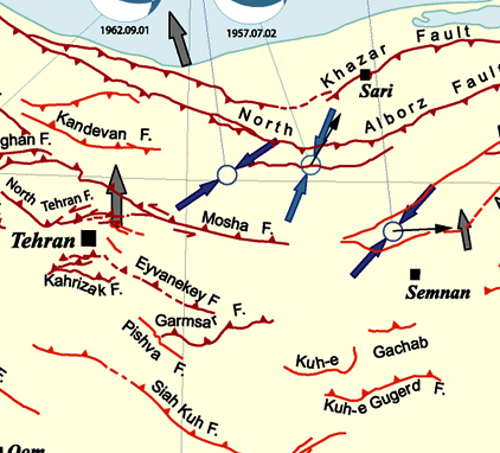![]() The Guardian reports that the Iranian government has approved plans for a new capital city. It seems this decision was at least partially driven by fears that the present capital, Tehran, is facing some serious earthquake hazard in the future:
The Guardian reports that the Iranian government has approved plans for a new capital city. It seems this decision was at least partially driven by fears that the present capital, Tehran, is facing some serious earthquake hazard in the future:
Plans for a new capital were first drawn up 20 years ago, but officials only gave them serious consideration after the 2003 earthquake that devastated the south-eastern city of Bam and killed an estimated 40,000 people. Experts warn that Tehran sits on at least 100 faultlines – including one nearly 60 miles long – and that many of its buildings would not survive a major quake.
Iran is part of the Alpine-Himalyan Belt, formed as the African, Arabian and Indo-Australian plates all push northwards into Eurasia. In Iran, seismicity is concentrated in the Zagros mountains in the south and the Alborz mountains in the North, with both of these mountain belts apparently being actively uplifted as they accommodate plate convergence.

Tehran, with a population of about 12 million people, is located just on the southern edge of the Alborz mountains, and a map of the major faults in the area shows that it is surrounded on all sides by sizeable thrust faults.

So, at first glance a relocation seems like a fairly foresighted strategy, even if a cynic (who, me?) might wonder if the move encompasses more than the political elite and their associated minions. But population centres do not generally spring up at random; there are usually strategic and/or economic reasons that people have settled in a particular location, and once established they tend to suck in ever more people and investment as time goes on. Add to that our general inertia in the face of abstract future risk (just look at the response to climate change) and you have to wonder if people will be all that willing to move. There’s also the question of how the cost of abandoning all the infrastructure incorporated into a large city like Tehran, and building a whole new infrastructure in your new city, compares to the cost of increasing peoples’ safety by enforcing robust building codes: after all, earthquakes don’t kill people, collapsing buildings do*.
In the long term, of course, it makes sense to move as much of your population as possible from areas of high seismic risk to low risk areas, by encouraging investment in geologically safer areas and letting economic migration rebalance the population over a generation or three. Sadly, I suspect urban planning is generally driven by somewhat narrower, short-term factors; if building houses on flood plains is waved through without blinking, I can’t see nearby faults giving people much pause.
*and tsunamis. But not in Tehran.





Nice plan for content warnings on Mastodon and the Fediverse. Now you need a Mastodon/Fediverse button on this blog.